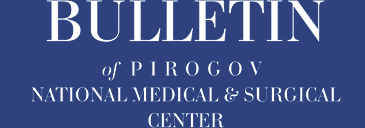Authors
Aslanov A.D.1, 2, Kalibatov R.M.1, 3, Logvina O.E.1, Kardanova L.Yu.1, 2, Baksanokov Z.H.5, Bakov Z.N.4
1 Kabardino-Balkarian State University named after H.M. Berbekov, Nal’chik
2 Republican Clinical Medical and Surgical Center of the Ministry of Health of the KBR, Nal’chik
3 Ministry of Health of the Kabardino-Balkarian Republic, Nal’chik
4 Republican Clinical Multidisciplinary Center of High Medical Technologies of the Ministry of Health of the KBR, Nal’chik
5 Central district Hospital of the Tersk district, Terek
Abstract
Backgraund: One of the common complications of GI is mechanical jaundice. This complication is accompanied by a high mortality rate.
Aims: to reduce the risk of complications of cholelithiasis by restoring the outflow of bile from the liver as soon as possible and selecting antibacterial therapy.
Materials and methods: 366 patients without cholangitis clinic and without increased amylase levels were analyzed. The patients were divided into 3 groups: the first – patients with prolonged use of antibacterial therapy, the second – patients with short–term use of antibacterial therapy, the third - patients who underwent endoscopic manipulations.
Results: the results of the comparative analysis indicated that only the combined use of each of the groups leads to a favorable outcome in patients with cholelithiasis.
Conclusions: the study confirms that combined treatment, taking into account bacteriological analysis and the special clinical circumstances of patients, can significantly improve outcomes and reduce mortality. Future research should focus on optimizing antibiotic therapy regimens to improve their effectiveness and safety.
Keywords: gallstone disease, mechanical jaundice, antibacterial therapy, resistance.
References
1. Kukosh MV, Demchenko VI, Kolesnikov DL, et al. Etapnoe lechenie mekhanicheskoj zheltuhi, vyzvannoj zhelchnokamennoj bolezn’yu. Ul’yanovskij mediko-biologicheskij zhurnal. 2018;2: 26-30. (In Russ.) doi: 10.23648/UMBJ.2018.30.13987.
2. Khat’kov IE, Avanesyan RG, Akhaladze GG, et al. Russian consensus on current issues in the diagnosis and treatment of obstructive jaundice syndrome. Pirogov Russian Journal of Surgery. 2020; 6: 5-17. (In Russ.) doi: 10.17116/hirurgia20200615.
3. Spellberg B, Guidos R, Gilbert D, et al. The epidemic of antibiotic-resistant infections: a call to action for the medical community from the Infectious Diseases Society of America. Clin Infect Dis. 2008; 46(2): 155-164. doi: 10.1086/524891.
4. Sokal A, Sauvanet A, Fantin B, de Lastours V. Acute cholangitis: Diagnosis and management. J Visc Surg. 2019; 156(6): 515-525. doi: 10.1016/j. jviscsurg.2019.05.007.
5. Haal S, Ten Böhmer B, Balkema S, et al. Antimicrobial therapy of 3 days or less is sufficient after successful ERCP for acute cholangitis. United European Gastroenterol J. 2020; 8(4): 481-488. doi: 10.1177/2050640620915016.
6. Masuda S, Koizumi K, Uojima H, et al. Effect of Antibiotic Resistance of Pathogens on Initial Antibiotic Therapy for Patients With Cholangitis. Cureus. 2021; 13(10): e18449. doi: 10.7759/cureus.18449.
7. Kang CI, Sung YK, Lee KH, Lee KT, Lee JK. Clinical impact of inappropriate initial antimicrobial therapy on outcome in bacteremic biliary tract infections. Scand J Infect Dis. 2013; 45(3): 227-234. doi: 10.3109/00365548. 2012.730151.
8. Satake M, Yamaguchi Y. Three-day antibiotic treatment for acute cholangitis due to choledocholithiasis with successful biliary duct drainage: A single-center retrospective cohort study. Int J Infect Dis. 2020; 96: 343-347. doi: 10.1016/j.ijid.2020.04.074.
9. Tinusz B, Szapáry L, Paládi B, et al. Short-Course Antibiotic Treatment Is Not Inferior to a Long-Course One in Acute Cholangitis: A Systematic Review. Dig Dis Sci. 2019; 64(2): 307-315. doi: 10.1007/s10620-018-5327-6.
10. Limmathurotsakul D, Netinatsunton N, Attasaranya S, et al. An Open-Labeled, Randomized Controlled Trial Comparing between Short Duration and Standard 14 Days Antibiotic Treatments for Acute Cholangitis in Patients with Common Bile Duct Stone after Successful Endoscopic Biliary Drainage. A Preliminary Report. Gastrointest. Endosc. 2014; 79: AB251.
11. Sawyer RG, Claridge JA, Nathens AB, et al. Trial of Short-Course Antimicrobial Therapy for Intraabdominal Infection. N. Engl. J. Med. 2015; 372: 1996-2005.
12. Kogure H, Tsujino T, Yamamoto K, et al. Fever-based antibiotic therapy for acute cholangitis following successful endoscopic biliary drainage. J Gastroenterol. 2011; 46(12): 1411-1417. doi: 10.1007/s00535-011-0451-5.
13. Uno S, Hase R, Kobayashi M, et al. Short-course antimicrobial treatment for acute cholangitis with Gram-negative bacillary bacteremia. Int J Infect Dis. 2017; 55: 81-85. doi: 10.1016/j.ijid.2016.12.018.
14. Gomi H, Takada T, Hwang TL, et al. Updated comprehensive epidemiology, microbiology, and outcomes among patients with acute cholangitis. J Hepatobiliary Pancreat Sci. 2017; 24(6): 310-318. doi: 10.1002/jhbp.452.
15. Hara T, Taniguchi M, Hattori C, et al. Microbiological analysis of patients with first and recurrent episodes of acute cholangitis in a middle-sized hospital: A single-center retrospective study in rural North Kyoto, Japan. J Infect Chemother. 2022; 28(3): 413-419. doi: 10.1016/j.jiac.2021.11.025.


